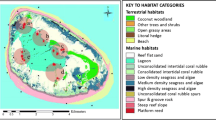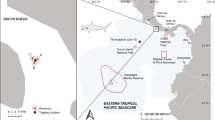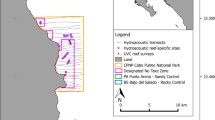Abstract
Atlantic whitefish (Coregonus huntsmani) are an endangered species located in only three lakes in Nova Scotia, Canada. Conservation efforts are directed toward increasing their range and number of viable populations. Current stocking programs use hatchery reared fish. The goal of the study was to determine the survival and distribution of hatchery reared Atlantic whitefish after release. Comparative hydroacoustic tracking experiments were performed to examine the survival, depth preferences and movements of hatchery reared and wild Atlantic whitefish. Hatchery reared fish were released to a non native lake whereas wild fish were released back to their native lake. Hatchery reared fish were ‘lost’ from the study lakes through presumed predation at a much higher rate (67 %) than wild released (6.5 %). Mortality rate in wild released fish was higher (50 %) than hatchery reared fish (20 %) and were likely due to the increased stress associated with handling or tagging. Movements were tracked over 248 and 342 days for wild captured and hatchery reared fish respectively. Hatchery reared fish were slow to disperse from the release site (mean ± standard error; 12 ± 3.2 days) and swam at the surface of the water for extended periods, which could have led to the unknown losses of these fish. After dispersal throughout the lake, however, the hatchery-reared fish were distributed in depths similar to those of the wild released fish, an important finding for the use of hatchery-reared fish in conservation. Results are discussed to improve hatchery practices for fish destined for stocking.






Similar content being viewed by others
References
Anras MLB, Lagardere JP (2004) Domestication and behaviour in fish. Prod Anim 17:211–215
Aprahamian MW, Smith KM, Mcginnity P, Mckelvey S, Taylor J (2003) Restocking of salmonids - opportunities and limitations. Fish Res 62:211–227
Araki H, Cooper B, Blouin MS (2007) Genetic effects of captive breeding cause a rapid, cumulative fitness decline in the wild. Science 318:100–103
Bradford RG, Longard D, Longue P (2004a) Status, trend and recovery considerations in support of an allowable harm assessment for Atlantic whitefish (Coregonus huntsmani). Can Sci Adv Secr Res Doc 2004/109
Bradford RG, Schaefer H, Stevens G (2004b) Scope for human induced mortality in the context of Atlantic whitefish (Coregonus huntsmani) survival and recovery. Can Sci Adv Secr Res Doc 2004/110
Bradford RG, Bentzen P, Campbell DM, Cook AM, Gibson AJF, Whitelaw J (2010) Update status report for atlantic whitefish (Coregonus huntsmani). Can Sci Advis Sec Res Doc 2010/005. vi + 39 p
Brennan NP, Darcy MC, Leber KM (2006) Predator-free enclosures improve post-release survival of stocked common snook. J Exp Mar Biol Ecol 335:302–311
Brokordt KB, Fernandez M, Gaymer CF (2006) Domestication reduces the capacity to escape from predators. J Exp Mar Biol Ecol 329:11–19
Cresswell RC, Williams R (1983) Post-stocking movements and recapture of hatchery-reared trout released into flowing waters - effect of prior acclimation to flow. J Fish Biol 23:265–276
Edge TA (1984) Preliminary status of the Acadian whitefish (Coregonus canadensis). Can Field Nat 98:86–90
Frankham R (2008) Genetic adaptation to captivity in species conservation programs. Mol Ecol 17:325–333
Hindar K, Ryman N, Utter F (1991) Genetic effects of cultured fish on natural fish populations. Can J Fish Aquat Sci 48:945–957
Huntingford FA (2004) Implications of domestication and rearing conditions for the behaviour of cultivated fishes. J Fish Biol 65:122–142
Hutchings JA, Fraser DJ (2008) The nature of fisheries- and farming-induced evolution. Mol Ecol 17:294–313
Jentoft S, Aastveit AH, Torjesen PA, Andersen O (2005) Effects of stress on growth, cortisol and glucose levels in non-domesticated eurasian perch (Perca fluviatilis) and domesticated rainbow trout (Oncorhynchus mykiss). Comp Biochem Phys A 141:353–358
Lima SL, Dill LM (1990) Behavioral decisions made under the risk of predation: a review and prospectus. Can J Zool 68:619–640
Mackey G, Mclean JE, Quinn TP (2001) Comparisons of run timing, spatial distribution, and length of wild and newly established hatchery populations of steelhead in Forks Creek, Washington. N Am J Fish Manag 21:717–724
Mueller GA, Marsh PC, Foster D, Ulibarri M, Burke T (2003) Factors influencing poststocking dispersal of razorback sucker. N Am J Fish Man 23:270–275
Paukert CP, Ward DL, Sponholtz PJ, Hilwig KD (2005) Effects of repeated hoopnetting and handling on bonytail chub. J Freshw Ecol 20:649–653
Pister EP (2001) Wilderness fish stocking: history and perspective. Ecosystems 4:279–286
Reisenbichler RR, McIntyre JD (1977) Genetic differences in growth and survival of juvenile hatchery and wild Steelehead Trout (Salmo gairdner). J Fish Res Bd Can 34:123–128
Roland AE (1982) Geological background and physiography of Nova Scotia. The Nova Scotian Institute of Science, Halifax
Sokal RR, Rohlf FJ (1981) Biometry. W.H. Freeman & Co., San Francisco
Sinclair ARE, Pech RP, Dickman CR, Hik D, Mahon P, Newsome AE (1998) Predicting effects of predation on conservation of endangered prey. Conserv Biol 12:564–575
Sjoberg K (1985) Foraging activity patterns in the goosander (Mergus merganser) and the red-breasted merganser (M. serrator) in relation to patterns of activity in their major prey species. Oecologia 67(1):35–39
Waples RS (1999) Dispelling some myths about hatcheries. Fisheries 24:12–21
Wildhaber ML, Lamberson PJ (2004) Importance of the habitat choice behavior assumed when modeling the effects of food and temperature on fish populations. Ecol Model 175:395–409
Acknowledgments
This work was supported by the Endangered Species Recovery Fund through the World Wildlife Federation to PB and AMC, and an NSERC Discovery Grant to PB. The authors acknowledge the work of Bev Davison and John Whitelaw at the Mersery Biodiversity Facility, Department of Fisheries and Oceans who raised and released the hatchery-reared fish. Recommendations by two anonymous reviewers significantly improved this manuscript. All experiments were reviewed and approved by the Dalhousie University Animal Care Committee prior to the initiation of experiments.
Author information
Authors and Affiliations
Corresponding author
Rights and permissions
About this article
Cite this article
Cook, A.M., Bradford, R.G. & Bentzen, P. Hydroacoustic tracking of the endangered Atlantic whitefish (Coregonus huntsmani); comparative analysis from wild and hatchery reared populations. Environ Biol Fish 97, 955–964 (2014). https://doi.org/10.1007/s10641-013-0197-4
Received:
Accepted:
Published:
Issue Date:
DOI: https://doi.org/10.1007/s10641-013-0197-4




